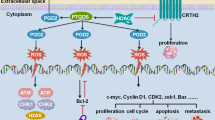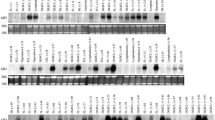Abstract
Indoleamine 2,3-dioxygenase (IDO) exerts immunomodulatory effects due to enzymatic activities catalyzing the essential amino acid l-tryptophan. IDO activity might play an important role in regulating immune responses exerted by antigen-presenting cells as a potent tool to help escape from assault by the immune system. In this study, we performed immunohistochemical analysis for IDO expression using mouse anti-human IDO monoclonal antibody in 119 tissue samples of diffuse large B-cell lymphoma (DLBCL) obtained before treatment with rituximab, cyclophosphamide, doxorubicin, vincristine, and prednisone (R-CHOP). Not only the lymphoma cells themselves but also dendritic cells (DCs) expressed IDO. Positive IDO expression in lymphoma cells was found in 38 cases (32%). Complete remission rates in patients with IDO-positive DLBCL and IDO-negative DLBCL were 55.3% and 79.0% (p = 0.008), while 3-year overall survival rates were 49.8% and 78.8%, respectively (p = 0.0003). IDO activity might thus play an important role in DLBCL and cells that express IDO appear important for determining outcomes after R-CHOP treatment. IDO might represent a candidate therapeutic target for DLBCL patients who show resistance to chemotherapy.


Similar content being viewed by others
References
Swerdlow SH, Campo E, Harris NL (2008) WHO classification of tumours of haematopoietic and lymphoid tissues, 4th edn. IARC, Lyon, pp 11–12
Nicolaides C, Dimou S, Pavlidisa N (1998) Prognostic factors in aggressive Non-Hodgkin’s lymphomas. Oncologist 3:189–197
The International Non-Hodgkin’s Lymphoma Prognostic Factors Project (1993) A predictive model for aggressive non-Hodgkin’s lymphoma. N Engl J Med 329:987–994
Hara T, Tsurumi H, Takemura M, Goto H, Yamada T, Sawada M et al (2000) Serum-soluble fas level determines clinical symptoms and outcome of patients with aggressive non-Hodgkin’s lymphoma. Am J Hematol 64:257–261
Goto N, Tsurumi H, Takemura M, Hara T, Sawada M, Kasahara S et al (2006) Serum-soluble tumor necrosis factor receptor 2 (sTNF-R2) level determines clinical outcome in patients with aggressive non-Hodgkin’s lymphoma. Eur J Haematol 77:217–225
Coiffier B, Lepage E, Briere J, Herbrecht R, Tilly H, Bouabdallah R et al (2002) CHOP chemotherapy plus rituximab compared with CHOP alone in elderly patients with diffuse large-B-cell lymphoma. N Engl J Med 346:235–242
Boon T, van der Bruggen P (1996) Human tumor antigens recognized by T lymphocytes. J Exp Med 183:725–729
Mellor AL, Munn DH (1999) Tryptophan catabolism and T-cell tolerance: immunosuppression by starvation? Immunol Today 20:469–473
Frumento G, Rotondo R, Tonetti M, Damonte G, Benatti U, Ferrara GB (2002) Tryptophan-derived catabolites are responsible for inhibition of T and natural killer cell proliferation induced by indoleamine 2, 3-dioxygenase. J Exp Med 196:459–468
Uyttenhove C, Pilotte L, Theate I, Stroobant V, Colau D, Parmentier N et al (2003) Evidence for a tumoral immune resistance mechanism based on tryptophan degradation by indoleamine 2, 3-dioxygenase. Nat Med 9:1269–1274
Munn DH, Sharma MD, Lee JR, Jhaver KG, Johnson TS, Keskin DB et al (2002) Potential regulatory function of human dendritic cells expressing indoleamine 2, 3-dioxygenase. Science 297:1867–1870
Hoshi M, Ito H, Fujigaki H, Takemura M, Takahashi T, Tomita E et al (2009) Indoleamine 2, 3-dioxygenase is highly expressed in human adult T-cell leukemia/lymphoma and chemotherapy changes tryptophan catabolism in serum and reduced activity. Leuk Res 33:39–45
Yoshikawa T, Hara T, Tsurumi H, Goto N (2010) Serum concentration of L-kynurenine predicts the clinical outcome of patients with diffuse large B-cell lymphoma treated with R-CHOP. Eur J Haematol 84(4):304–309
Sehn LH, Berry B, Chhanabhai M, Fitzgerald C, Gill K, Hoskins P et al (2007) The revised International Prognostic Index (R-IPI) is a better predictor of outcome than the standard IPI for patients with diffuse large B-cell lymphoma treated with R-CHOP. Blood 109:1857–1861
Miller AA, Salewski E (1994) Prospects for pirarubicin. Med Pediatr Oncol 22:261–268
Takagi T, Oguro M (1987) (2″-R)-4′-o-tetrahydropyranyladriamycin, a new anthracycline derivative; its effectiveness in lymphoid malignancies. Cancer Chemother Pharmacol 20:151–154
Tsurumi H, Yamada T, Sawada M, Kasahara S, Kanemura N, Kojima Y et al (2004) Biweekly CHOP or THP-COP regimens in the treatment of newly diagnosed aggressive non-Hodgkin’s lymphoma. A comparison of doxorubicin and pirarubicin: a randomized phase II study. J Cancer Res Clin Oncol 130:107–113
Tsurumi H, Hara T, Goto N, Kanemura N, Kasahara S, Sawada M et al (2007) A phase II study of a THP-COP regimen for the treatment of elderly patients aged 70 years or older with diffuse large B-cell lymphoma. Hematol Oncol 25:107–114
Sawada M, Tsurumi H, Yamada T, Hara T, Fukuno K, Goto H et al (2002) A prospective study of P-IMVP-16/CBDCA: a novel salvage chemotherapy for patients with aggressive non-Hodgkin’s lymphoma who had previously received CHOP therapy as first-line chemotherapy. Eur J Haematol 68:354–361
Cheson BD, Horning SJ, Coiffier B, Shipp MA, Fisher RI, Connors JM et al (1999) Report of an international workshop to standardize response criteria for non-Hodgkin’s lymphomas. NCI Sponsored International Working Group. J Clin Oncol 17:1244
Takikawa O, Kuroiwa T, Yamazaki F, Kido R (1988) Mechanism of interferon-gamma action. Characterization of indoleamine 2, 3-dioxygenase in cultured human cells induced by interferon-gamma and evaluation of the enzyme-mediated tryptophan degradation in its anticellular activity. J Biol Chem 263:2041–2048
Hans CP, Weisenburger DD, Greiner TC, Gascoyne RD, Delabie J, Ott G et al (2004) Confirmation of the molecular classification of diffuse large B-cell lymphoma by immunohistochemistry using a tissue microarray. Blood 103:275–282
Martinez del Hoyo G, Martin P, Arias CF, Marin AR, Ardavin C (2002) CD8alpha + dendritic cells originate from the CD8alpha—dendritic cell subset by a maturation process involving CD8alpha, DEC-205, and CD24 up-regulation. Blood 99:999–1004
Friberg M, Jennings R, Alsarraj M, Dessureault S, Cantor A, Extermann M et al (2002) Indoleamine 2, 3-dioxygenase contributes to tumor cell evasion of T cell-mediated rejection. Int J Cancer 101:151–155
Chen W, Liang X, Peterson AJ, Munn DH, Blazar BR (2008) The indoleamine 2, 3-dioxygenase pathway is essential for human plasmacytoid dendritic cell-induced adaptive T regulatory cell generation. J Immunol 181:5396–5404
Molano A, Illarionov PA, Besra GS, Putterman C, Porcelli SA (2008) Modulation of invariant natural killer T cell cytokine responses by indoleamine 2, 3-dioxygenase. Immunol Lett 117:81–90
Munn DH, Sharma MD, Hou D, Baban B, Lee JR, Antonia SJ et al (2004) Expression of indoleamine 2, 3-dioxygenase by plasmacytoid dendritic cells in tumor-draining lymph nodes. J Clin Invest 114:280–290
Moffett JR, Namboodiri MA (2003) Tryptophan and the immune response. Immunol Cell Biol 81:247–265
Acknowledgement
The authors wish to thank Ms. Reiko Shinoda for her technical assistance.
Authorship
Contribution: S.N., M.H., and H.I. performed experiments; T.H., N.K., N.G., S.K., analyzed results and made the figures; K.S., Y.H., T.T., M.S., and T.T. contributed valuable tissues and clinical information; H.T., M.S. and H.M. designed the research and all authors contributed to writing and approved the paper.
Conflict of interest
The authors declare no competing financial interests.
Author information
Authors and Affiliations
Corresponding author
Rights and permissions
About this article
Cite this article
Ninomiya, S., Hara, T., Tsurumi, H. et al. Indoleamine 2,3-dioxygenase in tumor tissue indicates prognosis in patients with diffuse large B-cell lymphoma treated with R-CHOP. Ann Hematol 90, 409–416 (2011). https://doi.org/10.1007/s00277-010-1093-z
Received:
Accepted:
Published:
Issue Date:
DOI: https://doi.org/10.1007/s00277-010-1093-z




